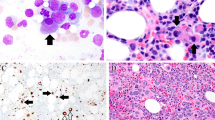Abstract
Sensitive quantification of minimal residual disease (MRD) using the polymerase chain reaction (PCR) is strongly predictive of outcome in childhood acute lymphoblastic leukemia (ALL), with MRD levels at the end of induction therapy of >10−3 predicting a poor outcome. Methods for sensitive quantification are, however, complicated and time-consuming. Detection by PCR of monoclonal immunoglobulin heavy chain (IgH) and T cell receptor (TCR) gene rearrangements is simple and can be used in routine laboratories but is non-quantitative and of lower but uncertain sensitivity. The aim of this study was to determine the value of detection of monoclonality in identification of different levels of MRD. We looked for monoclonality in 64 bone marrow aspirates which had been obtained from 31 patients with B lineage ALL at various times during induction therapy and for which levels of MRD had been determined by limiting dilution analysis using patient-specific PCR primers. Detection of monoclonality identified levels of MRD of ⩾10−3 during induction with a sensitivity of 78% and a specificity of 93%. The positive and negative predictive values were 0.86 and 0.88, respectively. The sensitivity of detection of a monoclonal IgH rearrangement was greater than that for the TCRγ locus during induction as an IgH rearrangement was detected more often than a TCRγ rearrangement in patients who had both IgH and TCRγ rearrangement at diagnosis. Detection of monoclonality is therefore a simple and quick test applicable to the majority of patients with ALL and it may be useful in identifying high-risk patients at the end of induction and in identifying relapsing patients later during therapy.
Similar content being viewed by others
Author information
Authors and Affiliations
Rights and permissions
About this article
Cite this article
Sykes, P., Snell, L., Brisco, M. et al. The use of monoclonal gene rearrangement for detection of minimal residual disease in acute lymphoblastic leukemia of childhood. Leukemia 11, 153–158 (1997). https://doi.org/10.1038/sj.leu.2400542
Received:
Accepted:
Issue Date:
DOI: https://doi.org/10.1038/sj.leu.2400542
- Springer Nature Limited
Keywords
This article is cited by
-
Comparison of methods for assessment of minimal residual disease in childhood B-lineage acute lymphoblastic leukemia
Leukemia (2001)
-
T cell receptor gamma (TCRG) gene rearrangements in T cell acute lymphoblastic leukemia reflect ‘end-stage’ recombinations: implications for minimal residual disease monitoring
Leukemia (2000)




